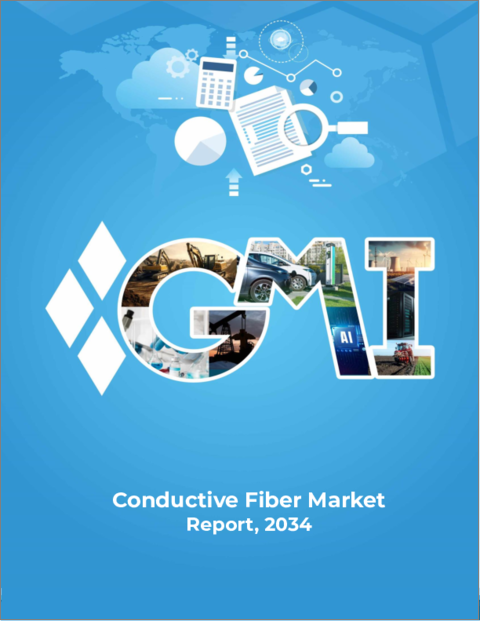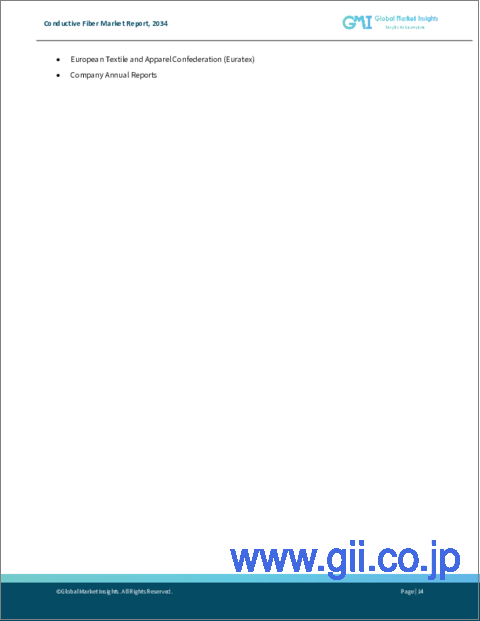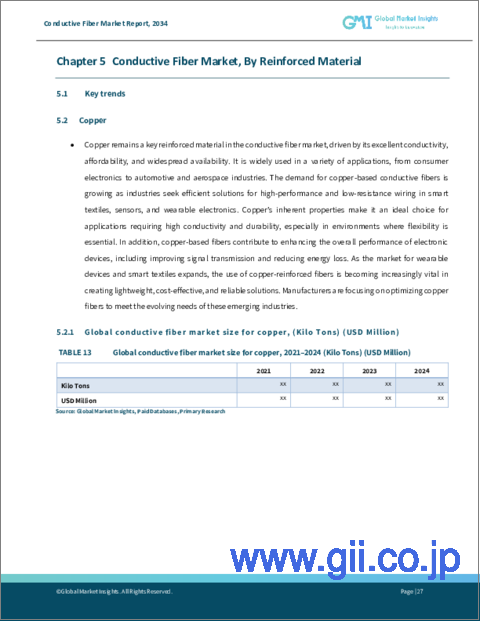|
|
市場調査レポート
商品コード
1572500
導電性繊維市場、市場機会、成長促進要因、産業動向分析と予測、2024年~2032年Conductive Fiber Market, Opportunity, Growth Drivers, Industry Trend Analysis and Forecast, 2024-2032 |
||||||
カスタマイズ可能
|
|||||||
| 導電性繊維市場、市場機会、成長促進要因、産業動向分析と予測、2024年~2032年 |
|
出版日: 2024年08月21日
発行: Global Market Insights Inc.
ページ情報: 英文 210 Pages
納期: 2~3営業日
|
- 全表示
- 概要
- 目次
世界の導電性繊維市場は、2023年に23億米ドルと評価され、2024年から2032年にかけてCAGR 12.3%以上で成長し、2032年には66億米ドルに達すると予測されています。
市場の成長を牽引しているのは、スマートウェア、フィットネストラッカー、ヘルスケアモニターなどのウェアラブル電子機器の採用が増加していることです。導電性繊維は、繊維製品にセンサーや電子部品を組み込むことを可能にし、機能性と快適性を高める。通信、自動車、航空宇宙、家電などの業界では、電子機器の採用が増加しており、効果的な電磁干渉シールドソリューションの需要が高まっています。材料科学の進歩により、耐久性、導電性、柔軟性を向上させた導電性繊維が開発されており、高度な金属コーティング繊維や本質的に導電性のポリマーなどがあります。
強化素材に基づくと、市場には炭素、銅、鉛、ニッケル、銀、その他が含まれます。銅セグメントが市場を独占し、2023年には6億8,600万米ドルとなり、2032年には19億8,400万米ドルに達すると予測されています。銅の優れた導電性は、効率的な電気トランスミッションを必要とする用途に理想的です。銅強化繊維は、センサー、アンテナ、RFIDタグ、その他の電子部品、スマートテキスタイルに使用されています。厳しい条件下でも導電性を維持するため、過酷な環境にも適しています。電子機器や通信における高速データ・トランスミッションの需要が、銅強化ファイバーの採用を後押ししています。これらのファイバーはケーブル、コネクタ、PCBに使われ、効率的な信号伝送を確保し、EMIを減少させます。銅はリサイクルが可能であるため、持続可能性という目標に合致し、市場の訴求力をさらに高めています。
基材別では、ナイロン、綿、ポリエステル、ポリアミド、ウール、その他があります。ポリエステル・セグメントが市場を牽引し、2023年の市場規模は6億8,630万米ドル、2032年には20億450万米ドルに達する見込みです。ポリエステルはコスト効率が高く、従来の繊維製造工程に適合するため、導電性繊維として魅力的です。ポリエステルベースの導電性繊維は柔軟で柔らかく、快適であるため、テキスタイルやウェアラブル・エレクトロニクスへの統合に適しています。
2023年の世界の導電性繊維市場はアジア太平洋地域が8億3,190万米ドルを稼ぎ出し、2032年には23億8,820万米ドルに達すると予測されています。日本、中国、台湾、韓国などの国々は、電子機器や繊維製品の主要な製造拠点です。この地域の高度な生産設備と熟練労働力が、導電性繊維の大規模生産を支えています。急速な工業化と都市化が、アジア太平洋地域におけるスマート・テキスタイル、電子機器、ウェアラブル技術の需要を牽引しています。
目次
第1章 調査手法と調査範囲
第2章 エグゼクティブサマリー
第3章 業界洞察
- エコシステム分析
- 主要メーカー
- 流通業者
- 業界全体の利益率
- 業界への影響要因
- 促進要因
- ウェアラブル・エレクトロニクスの需要増加
- 繊維技術の進歩
- ヘルスケア用途での採用増加
- 市場の課題
- 導電性繊維の高コスト
- 市場機会
- 新たな機会
- 成長可能性分析
- 促進要因
- 原料事情
- 製造動向
- 技術の進化
- 持続可能な製造
- グリーン・プラクティス
- 脱炭素化
- 原材料の持続可能性
- 価格動向(米ドル/トン)、2021年~2023年
- 規制と市場への影響
- ポーター分析
- PESTEL分析
第4章 競合情勢
- イントロダクション
- 企業マトリックス分析
- 企業シェア分析
- 地域別企業シェア分析
- 北米
- 欧州
- アジア太平洋
- ラテンアメリカ
- 中東アフリカ
- 地域別企業シェア分析
- 競合のポジショニング・マトリックス
- 戦略ダッシュボード
第5章 市場推計・予測:強化素材別、2021年~2032年
- 主要動向
- 銅
- 炭素
- ニッケル
- 鉛
- 銀
- その他
第6章 市場推計・予測:2021~2032年:基本材料別
- 主要動向
- 綿
- ナイロン
- ポリエステル
- ウール
- ポリアミド
- その他
第7章 市場推計・予測:用途別、2021~2032年
- 主要動向
- 不織布
- 織物
- ニット
第8章 市場推計・予測:最終用途別、2021年~2032年
- 主要動向
- 軍事・防衛
- 航空宇宙
- 家電
- 保護と安全
- ファッションとエンターテインメント
- アーキテクチャ
- その他
第9章 市場推計・予測:地域別、2021年~2032年
- 主要動向
- 北米
- 米国
- カナダ
- 欧州
- ドイツ
- 英国
- フランス
- イタリア
- スペイン
- アジア太平洋
- 中国
- インド
- 日本
- オーストラリア
- 韓国
- ラテンアメリカ
- ブラジル
- メキシコ
- アルゼンチン
- 中東・アフリカ
- 南アフリカ
- サウジアラビア
- アラブ首長国連邦
第10章 企業プロファイル
- Bekaert
- Covestro AG
- Hitek Electronic Materials Ltd.
- Kuraray Co Ltd
- Laird Performance Materials
- NV Bekaert SA
- Seiren Co. Ltd.
- Seiren Co., Ltd.
- Statex Produktions and Vertriebs GmbH
- Toray Industries
The Global Conductive Fiber Market was valued at USD 2.3 billion in 2023 and is projected to grow at a CAGR of over 12.3% from 2024-2032, reaching USD 6.6 billion by 2032. The market's growth is driven by the rising adoption of wearable electronic devices like smart clothing, fitness trackers, and healthcare monitors. Conductive fibers enable the integration of sensors and electronic components into textiles, enhancing functionality and comfort. Industries such as telecommunications, automotive, aerospace, and consumer electronics are increasingly adopting electronic devices, boosting the demand for effective electromagnetic interference shielding solutions. Advancements in materials science have led to the development of conductive fibers with improved durability, electrical conductivity, and flexibility, such as advanced metal-coated fibers and intrinsically conductive polymers.
The overall conductive fiber industry is classified based on the product, livestock, and region.
Based on reinforced material, the market includes Carbon, Copper, Lead, Nickel, Silver, and Others. The copper segment dominated the market, valued at USD 686.0 million in 2023 and projected to reach USD 1,984 million by 2032. Copper's excellent electrical conductivity makes it ideal for applications requiring efficient electrical transmission. Copper-reinforced fibers are used in sensors, antennas, RFID tags, other electronic components, and smart textiles. They maintain conductivity under challenging conditions, making them suitable for harsh environments. The demand for high-speed data transmission in electronics and telecommunications drives the adoption of copper-reinforced fibers. These fibers are used in cables, connectors, and PCBs to ensure efficient signal transmission and reduce EMI. Copper's recyclability aligns with sustainability goals, further boosting its market appeal.
Based on base material, the market includes nylon, cotton, polyester, polyamide, wool, and others. The polyester segment led the market, valued at USD 686.3 million in 2023 and expected to reach USD 2,004.5 million by 2032. Polyester's cost-effectiveness and compatibility with traditional textile manufacturing processes make it attractive for conductive fibers. Polyester-based conductive fibers are flexible, soft, and comfortable, suitable for integration into textiles and wearable electronics.
Asia-Pacific dominated the global conductive fiber market in 2023, generating USD 831.9 million, and projected to reach USD 2,388.2 million by 2032. Countries like Japan, China, Taiwan, and South Korea, are major manufacturing hubs for electronics and textiles. The region's advanced production facilities and skilled workforce support large-scale production of conductive fibers. Rapid industrialization and urbanization drive demand for smart textiles, electronic devices, and wearable technologies in Asia-Pacific.
Table of Contents
Chapter 1 Methodology and Scope
- 1.1 Market scope and definitions
- 1.2 Base estimates and calculations
- 1.3 Data collection
- 1.4 Forecast parameters
- 1.5 Data validation
- 1.6 Data sources
- 1.6.1 Primary
- 1.6.2 Secondary
- 1.6.2.1 Paid sources
- 1.6.2.2 Public sources
Chapter 2 Executive Summary
- 2.1 Industry 360° synopsis
Chapter 3 Industry Insights
- 3.1 Industry ecosystem analysis
- 3.1.1 Key manufacturers
- 3.1.2 Distributors
- 3.1.3 Profit margins across the industry
- 3.2 Industry impact forces
- 3.2.1 Growth drivers
- 3.2.1.1 Increasing demand for wearable electronics
- 3.2.1.2 Advancements in textile technology
- 3.2.1.3 Rising Adoption in healthcare applications
- 3.2.2 Market challenges
- 3.2.2.1 High cost of conductive fiber
- 3.2.3 Market opportunity
- 3.2.3.1 New opportunities
- 3.2.3.2 Growth potential analysis
- 3.2.1 Growth drivers
- 3.3 Raw material landscape
- 3.3.1 Manufacturing trends
- 3.3.2 Technology evolution
- 3.4 Sustainable manufacturing
- 3.4.1.1 Green practices
- 3.4.1.2 Decarbonization
- 3.4.2 Sustainability in raw materials
- 3.5 Pricing trends (USD/Ton), 2021 to 2023
- 3.5.1 North America
- 3.5.2 Europe
- 3.5.3 Asia Pacific
- 3.5.4 Latin America
- 3.5.5 Middle East and Africa
- 3.6 Regulations and market impact
- 3.7 Porter's analysis
- 3.8 PESTEL analysis
Chapter 4 Competitive Landscape, 2023
- 4.1 Introduction
- 4.2 Company matrix analysis
- 4.3 Company market share analysis
- 4.3.1 Company Market share analysis by region
- 4.3.1.1 North America
- 4.3.1.2 Europe
- 4.3.1.3 Asia Pacific
- 4.3.1.4 Latin America
- 4.3.1.5 Middle East Africa
- 4.3.1 Company Market share analysis by region
- 4.4 Competitive positioning matrix
- 4.5 Strategic dashboard
Chapter 5 Market Estimates and Forecast, By Reinforced Material, 2021 - 2032 (Kilo Tons) (USD Million)
- 5.1 Key trends
- 5.2 Copper
- 5.3 Carbon
- 5.4 Nickel
- 5.5 Lead
- 5.6 Silver
- 5.7 Other
Chapter 6 Market Estimates and Forecast, By Base Material, 2021 - 2032 (Kilo Tons) (USD Million)
- 6.1 Key trends
- 6.2 Cotton
- 6.3 Nylon
- 6.4 Polyester
- 6.5 Wool
- 6.6 Polyamide
- 6.7 Others
Chapter 7 Market Estimates and Forecast, By Application, 2021 - 2032 (Kilo Tons) (USD Million)
- 7.1 Key trends
- 7.2 Non-woven fabric
- 7.3 Woven fabric
- 7.4 Knitted fabric
Chapter 8 Market Estimates and Forecast, By End-use, 2021 - 2032 (Kilo Tons) (USD Million)
- 8.1 Key trends
- 8.2 Military and defense
- 8.3 Aerospace and aviation
- 8.4 Consumer electronics
- 8.5 Protection and safety
- 8.6 Fashion and entertainment
- 8.7 Architecture
- 8.8 Other
Chapter 9 Market Estimates and Forecast, By Region, 2021 - 2032 (Kilo Tons) (USD Million)
- 9.1 Key trends
- 9.2 North America
- 9.2.1 U.S.
- 9.2.2 Canada
- 9.3 Europe
- 9.3.1 Germany
- 9.3.2 UK
- 9.3.3 France
- 9.3.4 Italy
- 9.3.5 Spain
- 9.4 Asia Pacific
- 9.4.1 China
- 9.4.2 India
- 9.4.3 Japan
- 9.4.4 Australia
- 9.4.5 South Korea
- 9.5 Latin America
- 9.5.1 Brazil
- 9.5.2 Mexico
- 9.5.3 Argentina
- 9.6 Middle East and Africa
- 9.6.1 South Africa
- 9.6.2 Saudi Arabia
- 9.6.3 UAE
Chapter 10 Company Profiles
- 10.1 Bekaert
- 10.2 Covestro AG
- 10.3 Hitek Electronic Materials Ltd.
- 10.4 Kuraray Co Ltd
- 10.5 Laird Performance Materials
- 10.6 NV Bekaert SA
- 10.7 Seiren Co. Ltd.
- 10.8 Seiren Co., Ltd.
- 10.9 Statex Produktions and Vertriebs GmbH
- 10.10 Toray Industries






